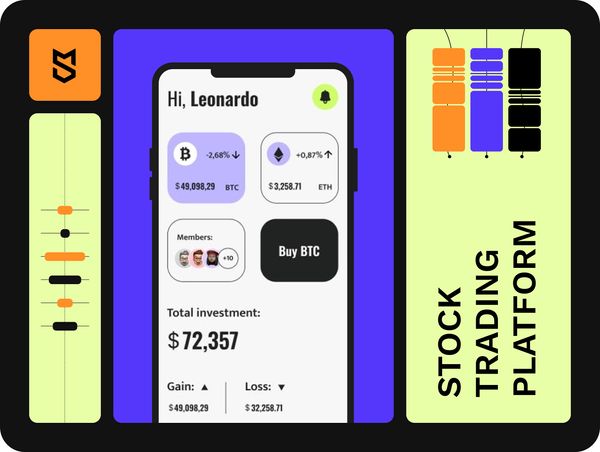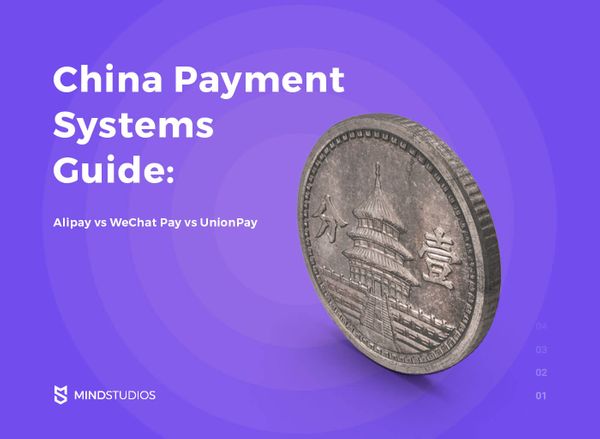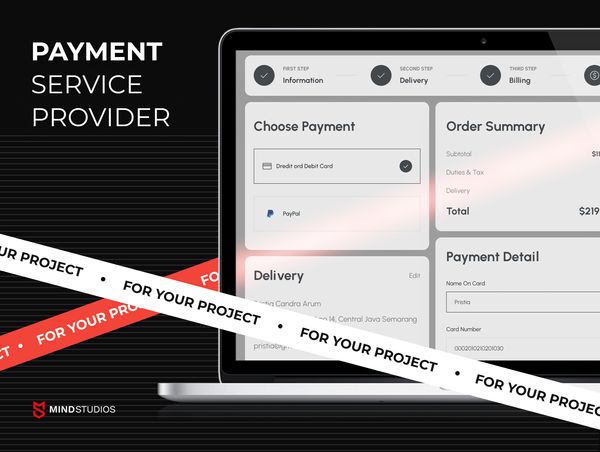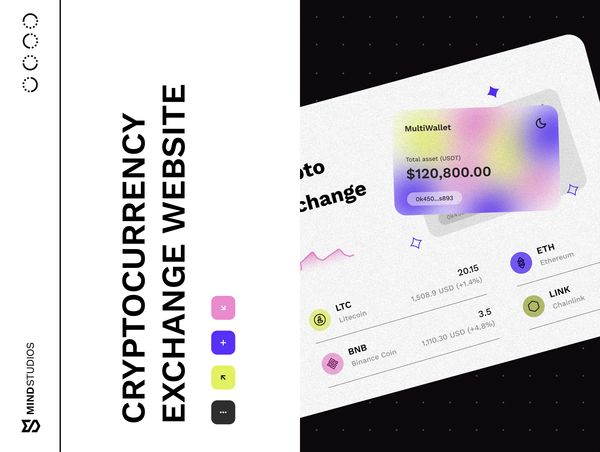
“Do you realize you want to build a cryptocurrency exchange website at a time when Celsius declares bankruptcy, and Gemini lays off 10% of its employees?
Are you crazy or what?”
This is pretty much how your fellows might react to your idea of building a bitcoin exchange website these days. Admittedly, their fears are not without merit.
According to Bitcoin.com, in Q2 2022, a myriad of crypto ventures have been suffering from the crypto winter. This results in massive staff cuts, withdrawal freezes, and significant insolvencies. Companies like Celsius, Voyager, and Three Arrows Capital have to file for bankruptcy protection. And these are crypto behemoths that have so far successfully overcome one crisis after another.
But let's admit that this volatility is what makes the crypto industry so enticing for entrepreneurs. But when you're down, the only way is up, isn't it? The crypto industry shows all signs of being resilient, after all.
So where one will surrender, the other will win. The difference is just in what cohort you want to belong to.
In this article, we'll provide you with three encouraging reasons why now is the best time ever to start your crypto exchange business.
We'll analyze how to create a cryptocurrency exchange website, make it high-speed and secure, and win the trust of your users. Finally, we'll focus on post-launch maintenance for you to do high-yield business in the long run.
If you firmly believe in proving all doubters wrong, let us walk you through the cryptocurrency exchange platform development: from why it might be a profitable idea to how to do it right.
Now or never: Three reasons to launch a crypto exchange platform in 2022
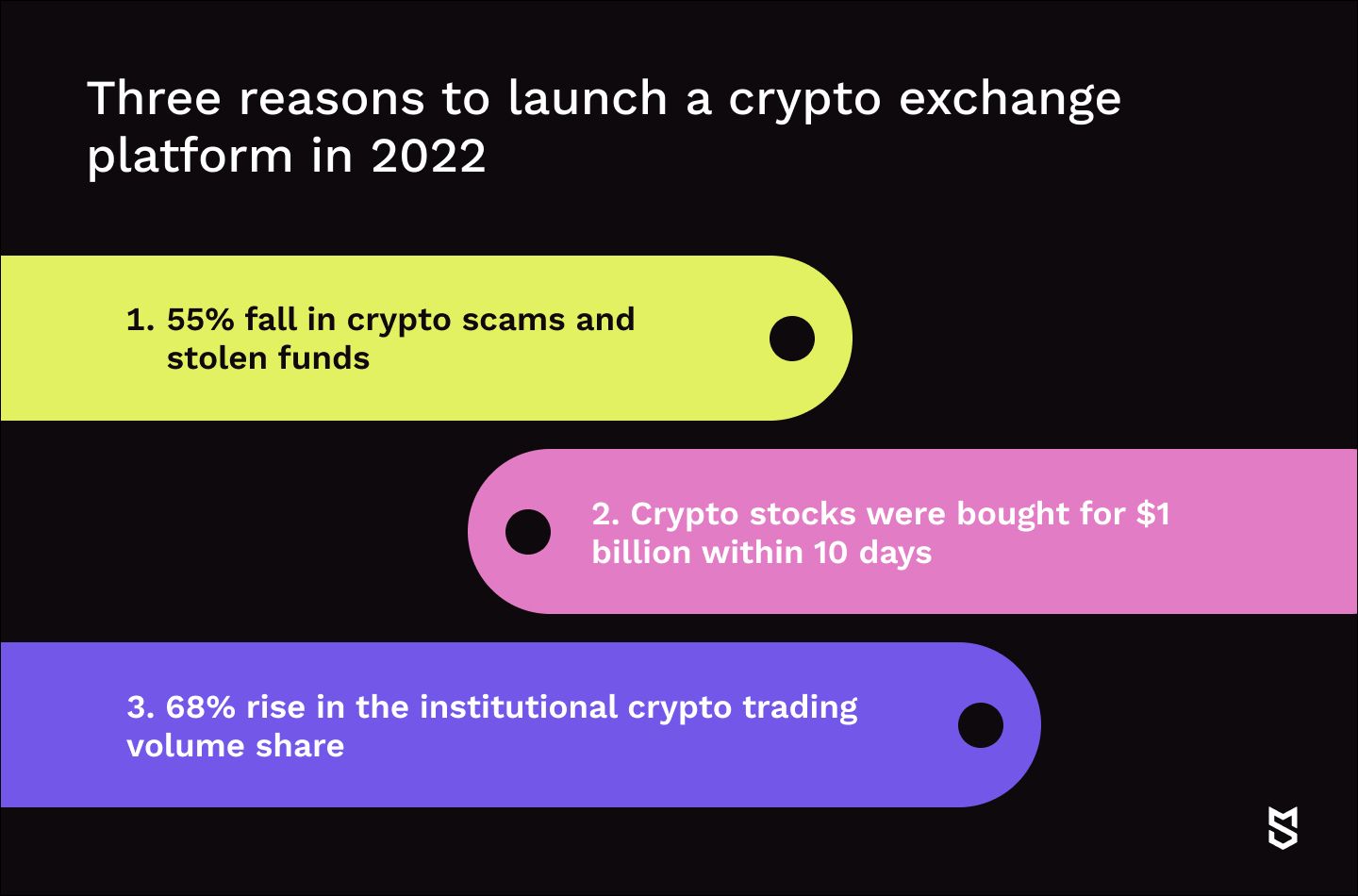
The controversial forecasts about the future of the cryptocurrency market for the rest of 2022 made the titles of various solid sources including Forbes, Time, CNBC, and Bloomberg. To help you build your own bitcoin exchange web app, let's laser our focus on the three most encouraging extracts from reports and experts’ pronouncements that could strengthen your decision:
1. 55% fall in crypto scams and stolen funds
According to the Coinjournal report, the second half of 2022 is expected to see fewer failed cryptocurrency exchange platforms — and by no less than 55%. This could be achieved because of the increased interest of U.S. officials in stablecoin regulations provoked by the recent Terra Luna crash.
Of course, there are both opponents and supporters of President Biden’s administration's policies regarding cryptocurrency regulations. However, a prevalent amount of experts agree that establishing clear laws and guidelines will make cryptocurrency safer for investors and less enticing for crypto criminals.
2. Crypto stocks were bought for $1 billion within 10 days
Within 10 days starting from July 15, 2022, retail traders have purchased nearly $1 billion worth of shares of crypto-exposed companies, according to Bloomberg. This massive infusion of funds has put Bitcoin on track for its first monthly gain since March likely saving it from the major plunge that everyone expected.
Meanwhile, the stocks of Marathon Digital Holdings Inc. have increased by 133%, and Coinbase Global Inc., Riot Blockchain Inc., and Silvergate Capital Corp. have all jumped by at least 50%. Since the end of June, the 10 best-performing US ETFs were also crypto-related.
3. 68% rise in the institutional crypto trading volume share
According to the report published by Boston Consulting Group (BCG), Bitget, and Foresight Ventures, the institutional trading volume on Coinbase has jumped from 20% in Q1 of 2018 up to 68% by the end of 2021.
Meanwhile, the bitcoin volatility index has slid from 0.053 between June 2017 and June 2018 to 0.039 between Jan 2021 and Dec 2021. Experts say that increased institutional adoption and decreased volatility of the crypto market show the early signs of the market maturing.
Despite the recent market disruption, it becomes clear that by the end of 2022 the fickle crypto market will likely become less fraudulent and more predictable. This, in turn, means more trust, more investors, and more transactions.
Taking into account a rough crypto exchange development time of four months, if you start immediately, you have all chances to bring your crypto site to the friendly-minded users at the very best time.
How to make a cryptocurrency exchange platform in 8 steps?
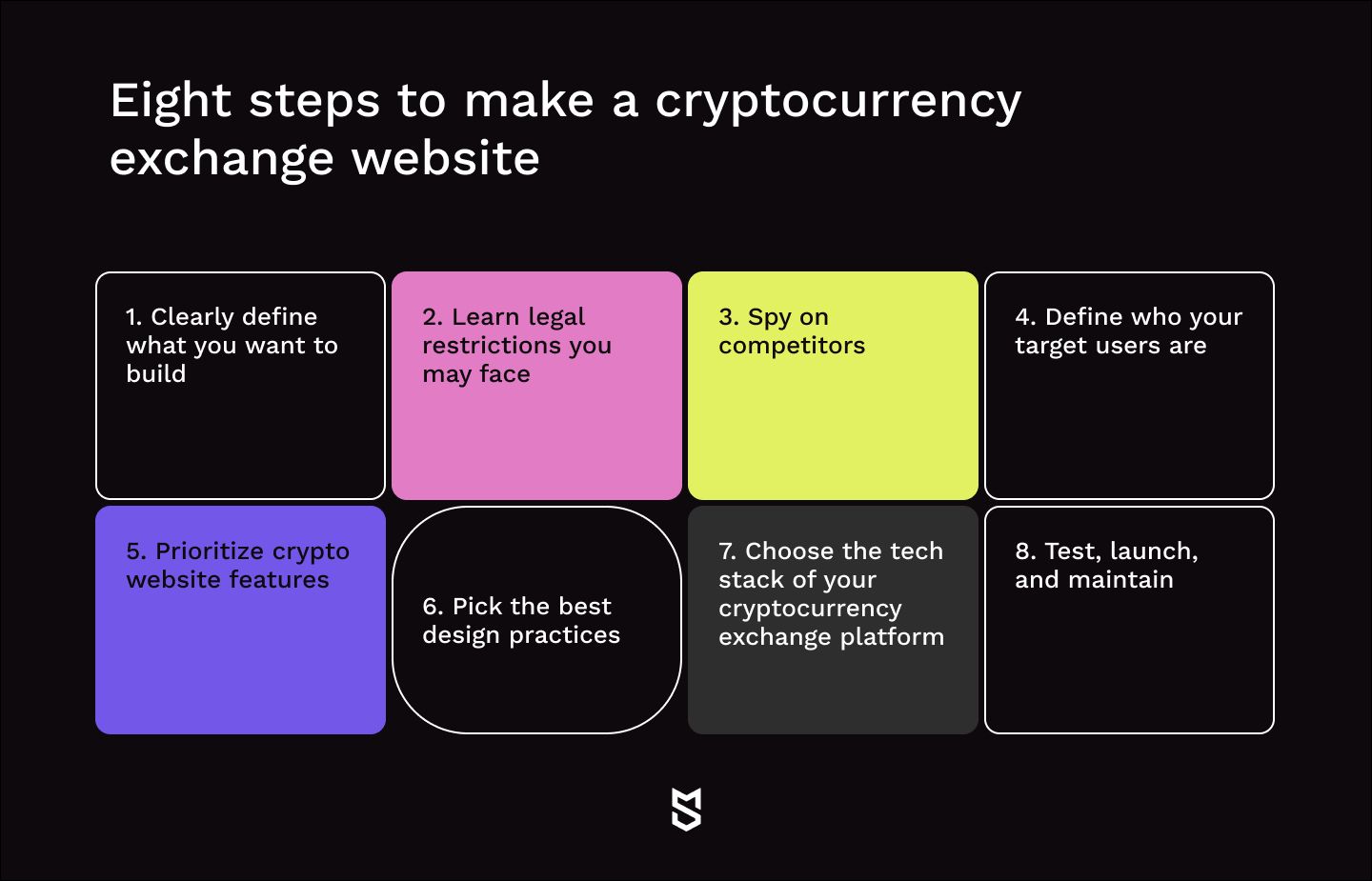
We hope previous information has vanished all your concerns that were dampening the prospects, and now you’re ready to learn how to make a crypto website that will win your users’ favor and sidestep all staunch competitors.
Based on our 9-year experience building mobile and web projects, we’ve broken down a somewhat abstract concept of the crypto exchange website development into eight clear and straightforward steps.
Step 1. Clearly define what you want to build
There are three main types of crypto exchange platforms you can build: centralized (CEX), decentralized (DEX), and hybrid (HEX). While all three offer users crypto selling, buying, and swapping facilities, they’re fundamentally different in terms of ease of use, features, security measures, transaction fees, etc.
If you build a centralized exchange
In this case, your crypto exchange platform will act as a centralized intermediary that records and validates orders and processes transactions within its database.
To make sure there’s no foul play such as money laundering, your platform will need to pass your users through Know Your Customer (KYC) verification procedures that comply with Anti-Money Laundering (AML) laws.
This means when registering, your users will need to provide their personal data including name, date of birth, address, ID number, and bank details. You'll require servers to process and store all this sensitive information on your centralized exchange platform. What's more, your CEX will be custodial, meaning it’ll store users’ funds in its wallets as well.
As you may guess, having full control over user-sensitive information and their crypto in your wallets is a double-edged sword. On the one hand, say, if your user loses their private keys, then your CEX can run a backup to help the user retrieve some funds.
The downside, however, is that users could lose all their funds if your centralized exchange gets hacked. Once your platform has access to users’ funds and accounts, it attracts cyber attackers like a magnet.
Pros:
- Allow users to use fiat currencies to buy crypto
- Provide a variety of unique features like limits, stop loss, or margin trading
- Deliver high liquidity since CEXs hold 95% of all crypto transactions
- Could have an intuitive and user-friendly interface
- Uncomplicated for any respectable development company, so its estimate will likely contain feasible values
Cons:
- Require to execute bullet-proof security measures to get licensed and counter cyberattacks
- Require to organize professional customer support which leads to costly post-launch maintenance
- Make you keep your transaction fees high, which could make your CEX less competitive
Examples: Coinbase, Bitcoin, FTX, Kraken
If you build a decentralized exchange
Imagine the exchange platform that is completely built to counter all CEXs shortcomings — and you’ll catch your DEX at work.
First, there’ll be no central entity, and all transactions will happen on a blockchain. All you need to do to allow trading to happen is to link your front-end with a blockchain and crypto wallet via smart contracts — simple lines of code formed in the self-executing “if/then” statements.
This also means that your DEX exchange will have neither direct control of users' crypto assets nor their personal information. Since DEXes don’t interact with fiat money, you won’t need to ask for your users’ personal details, ID, or bank details for KYC/AML compliance.
This can bribe users since you’ll give them full control over their crypto assets. However, in case your user loses their private keys, they’ll lose their associated assets forever because there’ll be no third party able to help them restore lost data.
Pros:
- Impressive functionality that allows your traders to borrow funds, leverage their positions, lend funds to passively earn interest, automatically convert one crypto to another, provide liquidity to collect trading fees, and more
- No need to invest in servers and multi-level security mechanisms (this function is embedded by secure and reliable smart contracts and DeFi protocols)
- Not much need in post-launch maintenance since all processes are automated
- Ability to set an almost non-existent transaction fee and turn it into your DEX’s unique selling point
Cons:
- Lower market participation — at least for now — that results in a lower trade volume and lower liquidity
- Rather complex design, so you need to put a lot of effort into making your DEX intuitive for all types of users, be it crypto experts or newbies
- DEX development will require hiring experienced (which is often a synonym for expensive) blockchain developers
- High gas fees, risk of impermanent loss for liquidity providers, and unprecedented additional costs or “slippage” for large orders
Examples: Bisq, UniSwap, SushiSwap, Binance DEX
If you build a hybrid exchange
How to make a crypto website that will involve the strengths of both CEXes and DEXes? The answer is — to build a hybrid exchange. With a HEX, you’ll provide your users with full control over their funds.
For example, you can offer users to keep a crypto wallet (hot or cold, each option is possible) or trade via smart contracts. What’s more, a hybrid exchange provides users with access to their private keys and is more flexible than a decentralized exchange in terms of scalability.
Pros:
- Well-defined and easy-to-use interface on a par with a CEX
- Followed by CEXes, provide the fastest processing speed
- Allow fiat-to-crypto and crypto-to-crypto operations
- Enable users to access liquidity from both DEX and CEX exchanges
- Zero taker fees and gas fees
Cons:
- Low liquidity
- Low trading volume
- The highest cost of development
Examples: Qurrex, Eidoo, Legolas, RhinoFi
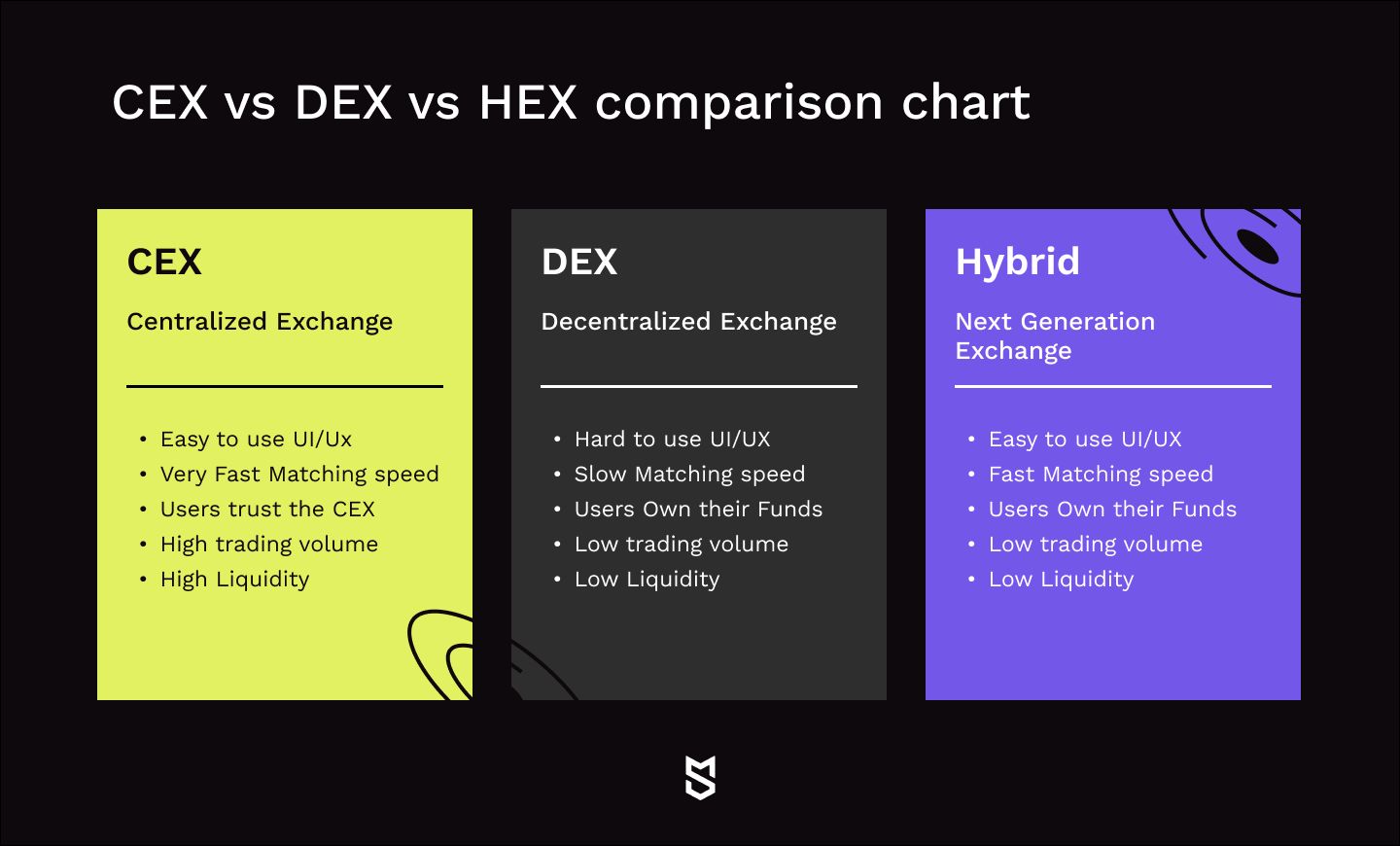
Every option has its pros and cons. To find a perfect solution for your business goals, it's worthwhile to include in brainstorming a competent project manager. This specialist will conduct a series of researches on your initial conditions, market trends, competitors, and target audience, and propose data-driven decisions on which type of exchange you should build.
Step 2. Learn what legal restrictions you may face
Once you decide to create a cryptocurrency exchange platform, you must pay utmost attention to all legal aspects that you’ll need to conform to in order to get licensed. Here, the type of your exchange platform will play a big role, because CEXes are more liable to follow rules and regulations of the country they are located in than HEXes and DEXes.
To run your CEX platform, you need a license to cooperate with banks, wallets, and payment systems as well as to conduct exchange transactions within the platform. The first hurdle here is that some countries forbid cryptocurrency transactions implicitly or even completely. For example, China, Bangladesh, Egypt, Qatar, and five more countries have absolute bans on cryptocurrency.
Since DEXes run on a distributed blockchain model, they’re considered as those not bound by any legal requirements anywhere. It’s not entirely true. As Rober Cohen, the Chief of the Cyber Unit said:
“The focus is not on the label you put on something or the technology you’re using. The focus is on the function, and what the platform is doing. Whether it’s decentralized or not, whether it’s on a smart contract or not, what matters is it’s an exchange.”
If you plan to operate in the US, for instance, your DEX could be subject to registering as a national securities exchange in the Securities and Exchange Commission (SEC).
To painlessly launch your cryptocurrency exchange website, be it CEX or DEX, in a particular country, you need to carefully explore:
- State’s attitude towards crypto businesses
- Features of corporate law
- Terms of cryptocurrency business registration
- Costs to register a crypto business and get a license
- Requirements for the authorized capital
- Political and economic stability
- Degree of infrastructure development
- General market openness
Step 3. Spy on competitors
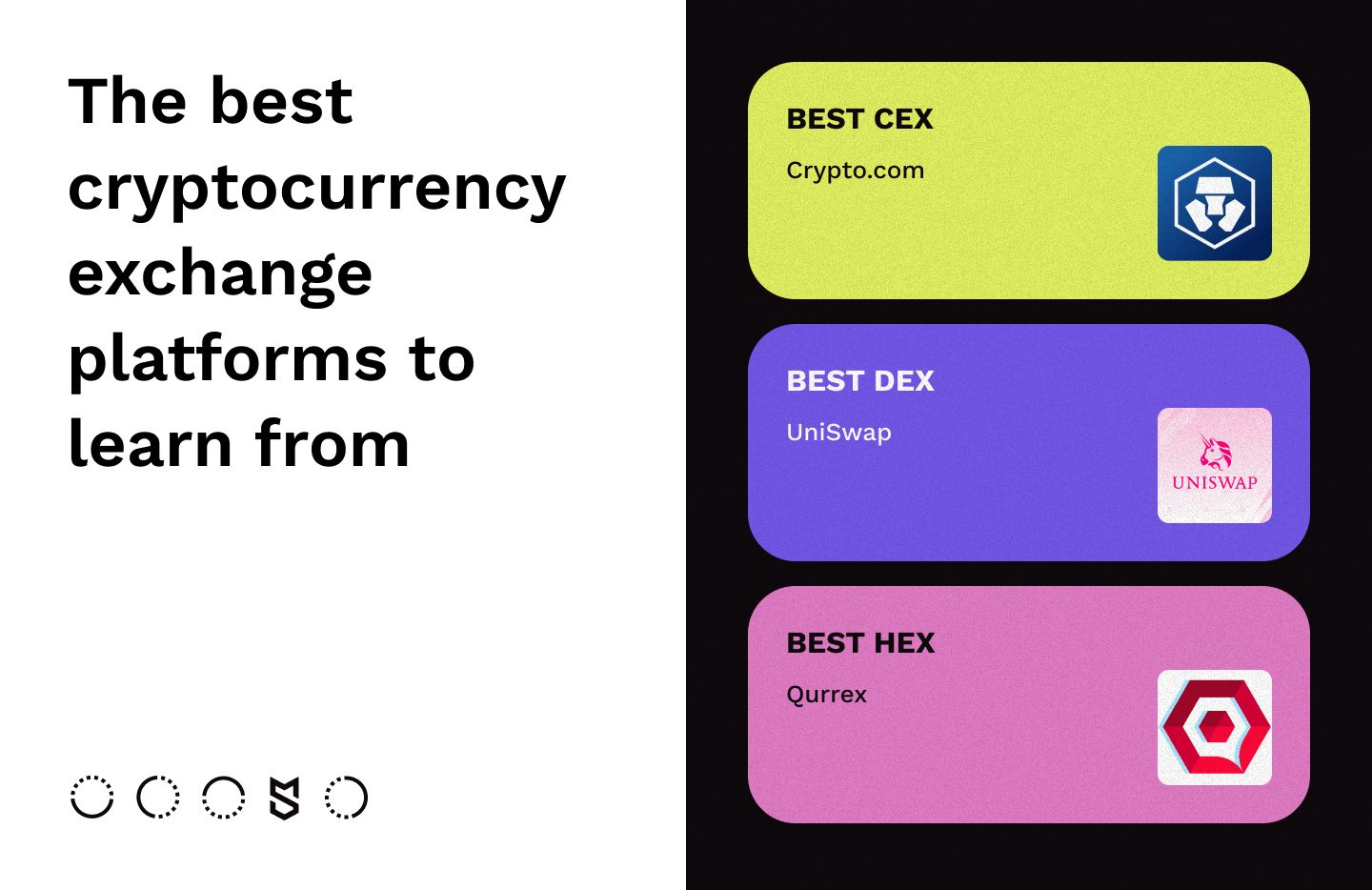
If you wonder how to make a crypto website marketable, you should obtain a thorough analysis of your direct competitors. Since there are three main types of exchange platforms we’ve described above, let’s explore the most popular cryptocurrency exchange websites in each category.
Best CEX: Crypto.com
Founded in 2016 in Hong Kong, Crypto.com has positioned itself as something of a supermarket for crypto enthusiasts with an impressive amount of features and products submitted on its website and mobile app. Now it is available in 90 countries and serves more than 10 million users worldwide.
What can you learn from Crypto’s popularity? Let’s take a closer look at its pros and cons:
| Pros | Cons |
|---|---|
| Over 250 coins and 20 fiat currencies supported | Slow and low-quality customer support responses according to Trustpilot reports |
| Competitive trading fees up to 0.40%, with discounts available | Lack of educational resources |
| Wide ecosystem composed of its own blockchain Crypto.org Chain, a native token called Cronos (CRO), a cashback visa card, a crypto wallet, and an NFT marketplace | Higher trading fees for low-volume traders unless users hold and use CRO |
| High-interest rates up to 14,5% per year on deposits of over 30 cryptocurrencies |
Best DEX: UniSwap
A bright representative of an automated market maker DEX run on Ethereum blockchain, UniSwap allows its users two things: 1) swap any ERC-20 token, which now is about 600 crypto coins; 2) become a liquidity provider and earn crypto with liquidity mining.
Launched in New York in November 2018, UniSwap topped $1 trillion in total trading volume and attracted around 3.9 million cumulative users by May 2022. With these stunning outcomes, UniSwap ranks well ahead of its competitors and is rightfully considered the largest and best DEX in the world.
Does it mean UniSwap has no drawbacks at all? Let’s see.
| Pros | Cons |
|---|---|
| Over 600 cryptocurrencies supported | No fiat-to-crypto transactions |
| Reasonable trading fees of 0.30% +network fees, with discounts available for higher-volume traders (down to 0.00%) | High gas fees |
| Full anonymity with no account registration and no KYC verification procedures | Risk of impermanent loss |
| Integration with both hot and cold wallets available | No insurance against lost cryptocurrency |
| Ability to swap tokens on the Polygon network or use the Optimism of Arbitrum bridges | Unsuitable for beginners |
| Ability to earn passive income with liquidity mining |
Best HEX: Qurrex
Founded in 2017 with headquarters in the Netherlands and the Cayman Islands, Qurrex became the world’s first hybrid crypto exchange platform that aimed at combining perks of DEXes and CEXes in one place.
One year after its founding, Qurrex launched its own digital token QRX that went for ICO. To entice entrepreneurs, it provided advanced white label solutions and market maker protocols. No less effectively Qurrex delivered on huge liquidity pools since it incentivizes major market liquidity providers.
Let’s find out what other tricks Qurrex has up its sleeve and what gaps it still needs to address:
| Pros | Cons |
|---|---|
| Top 40 cryptocurrencies and all ERC-20 tokens supported | Account creation and compliance with KYC/AML |
| White label plug-and-play solutions with advanced APIs like FIX/FAST, REST, and Webstock | Its own token QRX is restricted in the USA, Iran, Cuba, North Korea, and a few more countries |
| Basic maker fees and trader fees | Not regulated by any financial regulatory authority |
| Availability of fiat-to-crypto exchanges and fiat withdrawals | |
| Offers top-shelf security including cold wallet storage and insurance to protect against loss and theft | |
| 24/7 customer support |
As you see, even the most popular crypto exchange platforms have some pitfalls that leave room for alternatives. By analyzing your competitors, you’ll be able to clearly outline what they do wrong and what they do that is especially loved by their users. These insights will be a good help for creating a tangible vision of your cryptocurrency exchange platform that will make it serve customers in the best way possible.
Step 4. Define who your target users are
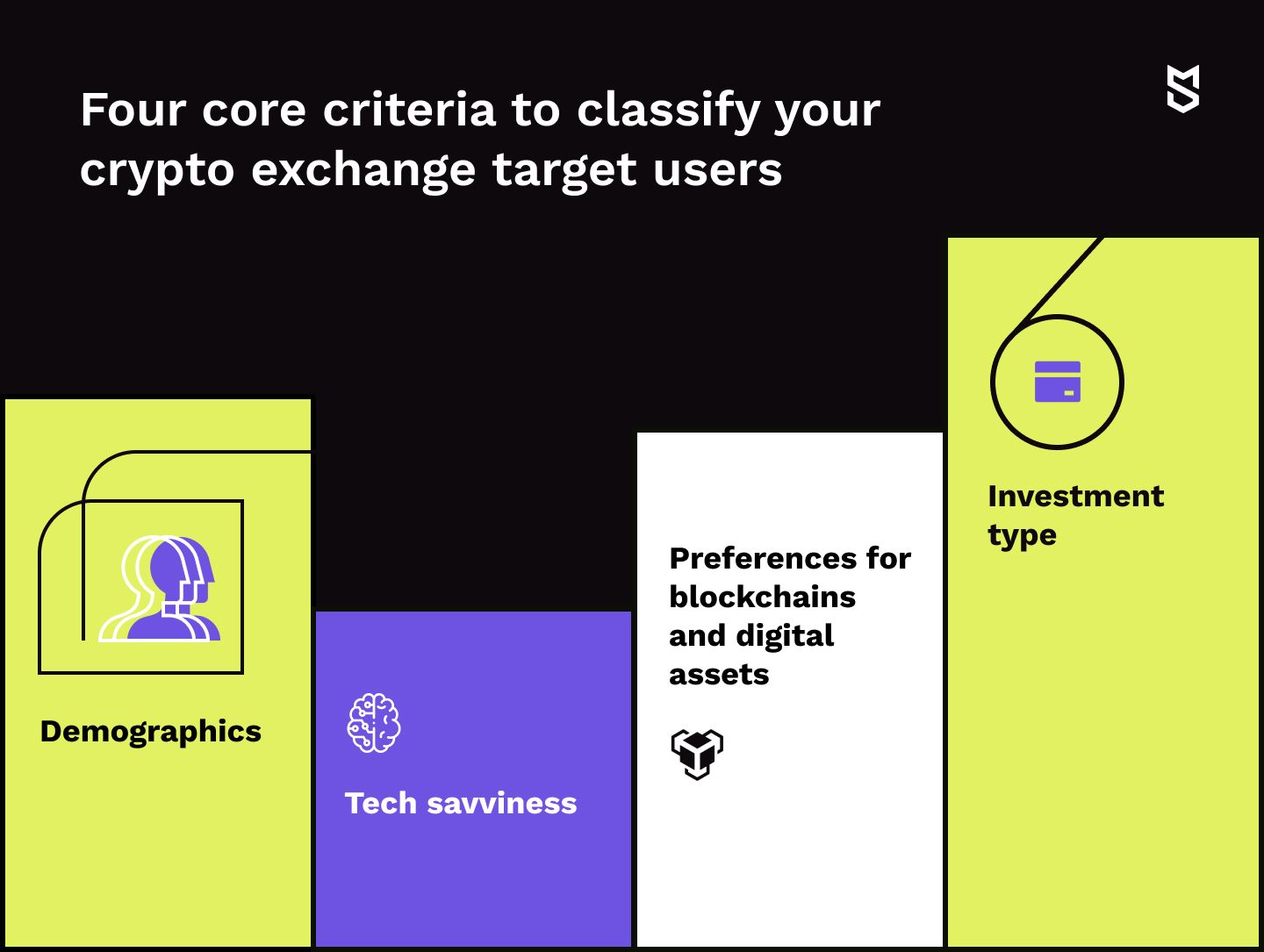
After conducting competitor analysis, dive deeper into your target user portrait and clarify their urgent needs and wants. This will help you reach a product-market fit and significantly cut your crypto exchange web app development costs at least because you’ll avoid many alterations.
Start with dividing your target audience into segments according to the following criteria:
Demographics
According to Finder research, 44.3% of American crypto investors are Millennials; 28.6 % are Gen X; 17.8% are Gen Z, and only 8.2% are Baby Boomers; with men investing in cryptocurrency more than twice as likely as women. In terms of their location, according to the Ceoworld Magazine report, the top five countries with the highest adoption of cryptocurrency are Thailand with 20.1% of users owning digital coins, Nigeria (19.4%), Philippines (19.4%), South Africa (19,4%), and Turkey (18.6%).
Tech savviness
Many crypto exchange startups built their USP around this target audience criteria. For example, Coinbase is considered the best platform for beginners with a lot of useful tutorials and an easy-to-navigate interface. According to Investopedia, Kraken is best for seasoned traders, as it provides advanced order types, highly-customizable chart analysis tools, and supports margin and futures trading.
So think how tech-savvy your target users are because it will have a huge impact on your subsequent crypto exchange web app development.
Preferences for blockchains and digital assets
With more than 1,000 blockchains and 19,000 cryptocurrencies, this criterion is one of the most important to consider. What cryptocurrencies do your target users respect the most? Do they prefer CEX, DEX, or HEX? Do they need fiat-to-crypto transactions? Do you need to add an NFT marketplace to your crypto exchange?
Investment type
Going back to the Finder report, you can find out that 68% of respondents use crypto as a form of investing. But investors are an extensive concept so you can subdivide them into:
- Individuals
- Liquidity providers
- Brokers
- Institutional investors
Each subgroup has its own needs, tasks, goals, and dreams. Since you've been in this business for years, you might be deceived by the bias that you know everything about your users. And you'll want to skip this step.
However, we have repeatedly found that careful target audience analysis can bring quite unexpected insights, even to industry veterans. So, to create a crypto exchange platform that will win your users' hearts, you need to carefully explore all their preferences prior to development instead of altering your site again and again while under the influence of negative reviews.
Step 5. Prioritize cryptocurrency exchange solution features
After conducting market research, competitor analysis, and target audience analysis, you might come up with an extensive list of features for your cryptocurrency exchange platform.
However, starting to implement all of them at once may cause a big problem: There’ll be too many features that will likely delay the development process for a long time and siphon too much money from you.
In this case, we recommend prioritizing the features while taking into account two parameters: 1) those without which your crypto exchange minimum viable product won’t work, so you need to implement them first; 2) those which you can add as a competitive advantage that turns your MVP into a version more loveable for users (known as MLP) but which won’t cost you a fortune.
Let's take a sneak peek at the must-have features first.
- Onboarding
- Simple and secure user registration
- User account
- Crypto wallets (hot and cold)
- Trading engine
- Fiat-to-crypto and crypto-to-crypto transactions
- Deposits/withdrawals
- Liquidity
- Constant analytics in dashboards and charts
- History of transactions and order book
- Notifications and alerts
- Round-the-clock customer support
- Admin panel
However, your aim is probably to not just create one more crypto website clone with a typical basic set of features. There must be a hook! Something that your users couldn't pass by. Something that will make them your adopters. Something that will reflect your brand identity.
Consider the following advanced features that can add a twist to your crypto exchange website.
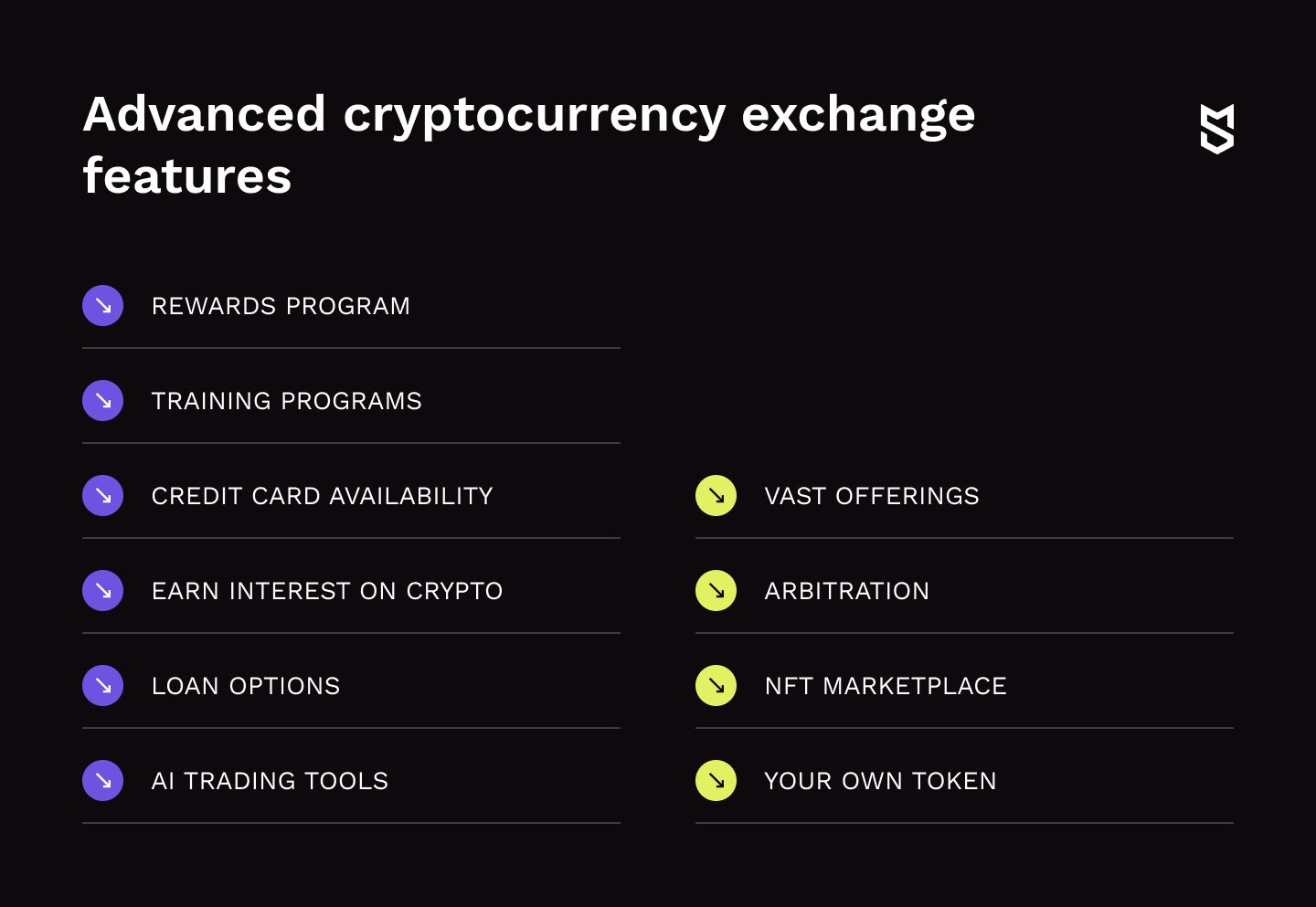
Step 6. Pick the best practices for your cryptocurrency exchange platform design
When you come to the cryptocurrency exchange design stage, it’s always about creating UX and then UI concepts. As for UX, guided by logic, you need to think of how your users will interact with your website and visualize their journey step-by-step. This will allow you to eliminate possible UX-related issues and make your crypto exchange website navigation neat and friendly for users.
In terms of UI, we recommend taking simplicity as a rule. The cryptocurrency exchange platform contains a lot of data in form of dashboards, charts, and graphics — so there’s no room for the heaped design. However, your crypto website UI design needs to emphasize your brand identity, for instance, as gold and silver blue do for Bitcoin.
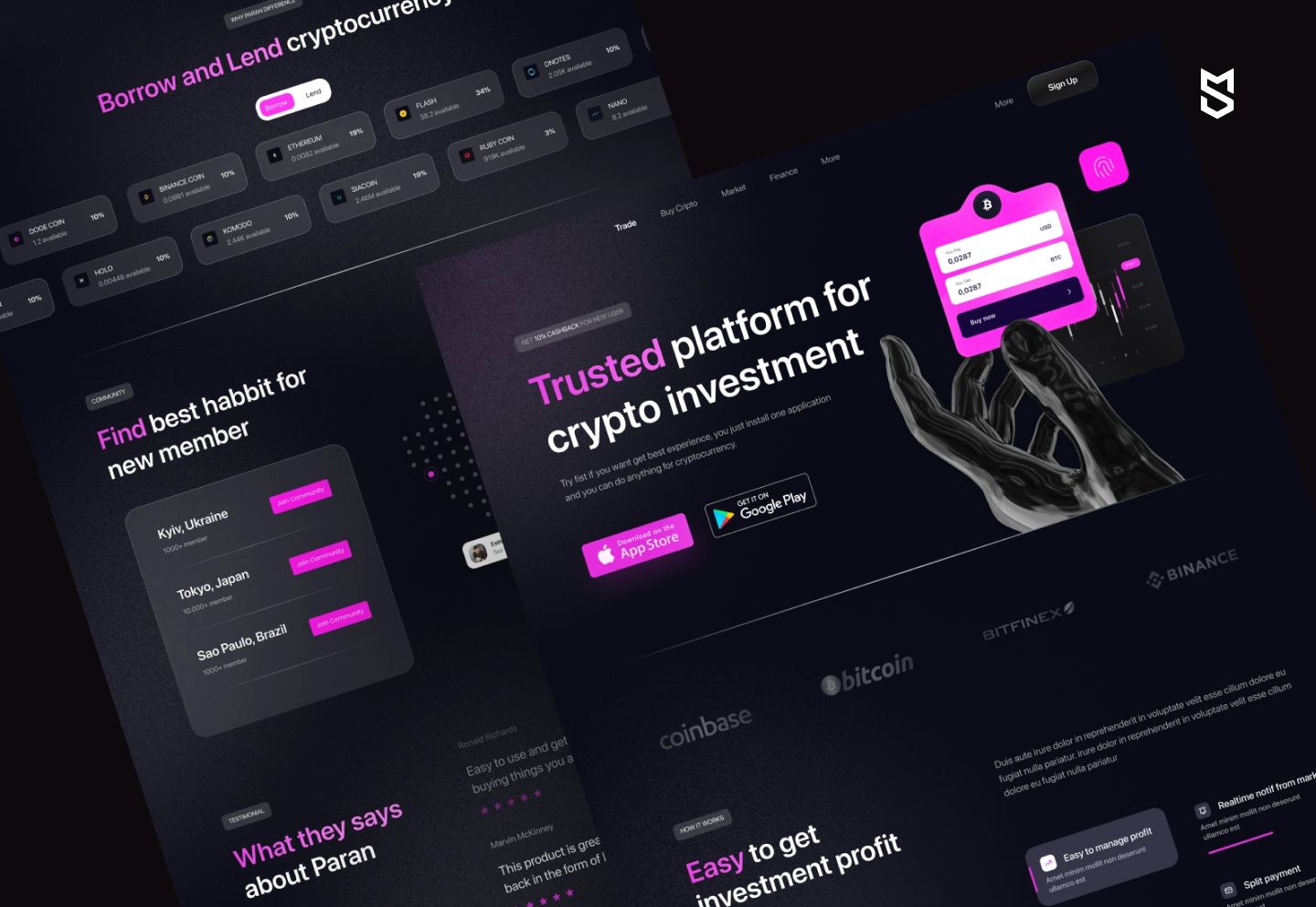
So how to make a bitcoin exchange website that will be attractive, intuitive, and recognizable? Here are four key tips from our designers:
1. For functionality
Avoid gatekeeping. Instead, teach your users how to interact with your platform straightforwardly and efficiently. Take an example from Coinbase’s “Learn and earn'' educational section. Also, allow users to make mistakes.
For example, Binance provides its users with a “cancel all orders'' button. What’s more, aligns with an open-door policy. Binance makes it possible for users to customize their home screens by adding or removing widgets. Gemini, in turn, has a custom price alerts option that allows users to get timely notifications when the price of the assets they’re interested in reaches a particular index.
2. For trust
Take your user's hand and carefully lead them through your platform explaining actions they’re about to take and how that will influence them. The good thing is to showcase the key features on the first login. Here, you can take an example of FTX onboarding which, apart from highlighting the guideline on how to use each feature for newcomers, effectively uses empty spaces where it shows the value of each feature. Gemini inserts empty spaces in cards, accompanied by additional copy and visuals.
3. For engagement
The most memorable experience your users will have is while browsing through your crypto website for the first time.
The key factor here is to allow them to browse through it! More often than not, when users first open a website or an app, they bump into the authorization process. In terms of crypto trading, this process can be time-consuming as it sometimes requires a user to upload their ID, enter a social security number, date of birth, address, phone number, and more.
If your user manages to successfully pass through registration — awesome, but if not? We think it’s sensible for engagement to allow the users who aren’t ready to go through identity verification yet to continue exploring your website and offer them to pass verification later.
4. For the crypto background
Keep heading to a minimalistic design of your crypto platform that could be lightly diluted with interactive graphic element patches or dynamic logos. Consider using the angled shapes, lines, and grids that are gaining popularity in cryptocurrency web development design now. Take into account other trends including futurism, metallic, globes, and neon-and-blue color schemes. After that, you can move on to the next step of how to develop a cryptocurrency exchange website.
Step 7. Approve your cryptocurrency exchange platform tech stack

At this step, you may still find yourself unsure on whether to refer to an out-of-the-box solution or build your own bitcoin exchange web app from scratch.
There are dozens of white-label crypto exchange platforms filled with tempting suggestions: launch your own crypto website fast; painlessly; cheap; with no tech skills required; with the help of experts; customized under your requirements…
But before jumping at these seemingly easy and cheap opportunities, we'd recommend you to also consider these drawbacks and weigh the pros against the cons:
- Your crypto exchange website will look like a copycat
- The owner of the code will be a third-party white-label service, not you
- It’ll be impossible to integrate unique top-of-shelf features into your crypto website
- The performance of your crypto exchange website will be questioned
Are you ready to put up with such drawbacks? If not, then building your own website from scratch will be your go-to option.
If you decide to run a bitcoin exchange website built from scratch, and it’ll be a centralized platform, the tech stack you may require can be as follows:
| Type of work | Technology |
|---|---|
| Frontend | JavaScript |
| Frontend framework | Vue.js, React.js, web3.js |
| Backend | Ruby, Node.js |
| Backend frameworks and libraries | Ruby on Rails (Ruby), Express/Nest.js (Node.js), Bootstrap (Admin panel UI) |
| Databases | MySQL, PostgreSQL, MongoDB |
| Trading engine | Algo engine, OMS |
| File storage | Amazon S3, CloudFront |
| Caching | Redis, Memcached |
| Hosting | AWS, GCP, Microsoft Azure, OVH |
| Extranet | TNS |
| Market data | Exegy |
| Order routing system | FIX API |
| Analytics and monitoring | Amazon CloudWatch, Datadog, Prometheus, ELK |
| Source code storage | GitHub, AWS CodeCommit, GitLab |
| Wallet providers | MetaMask APIs, Trust Wallet APIs |
| Linked account pay-ins | Stitch |
| Multifactor authentication | Twilio Authy |
In case it’s a decentralized or hybrid platform, you’ll be required to integrate smart contracts based on the blockchain you’ll choose as well as DeFi protocols and additional APIs.
Step 8. Test, launch, and maintain
Once your trial crypto website version is ready, it’s time to check it back and forth, identify bugs, and fix them before real users detect them. Your quality assurance engineers are those who are responsible for carrying out different testing procedures and timely informing developers about errors.
In terms of a crypto exchange website, QA specialists can perform:
- Registration process testing
- KYC verification testing
- Deposit and withdrawal testing
- Cryptocurrency buy/sell testing
- OWASP vulnerability testing
- Testing of APIs and WebSockets
- Testing smart contracts (if any)
When your cryptocurrency exchange platform reaches a set criteria of readiness, you can launch it and welcome the traders. From there onwards, post-launch maintenance is your team’s regular activity.
Remember, at the beginning of this article, we’ve promised to provide you with tips on how to effectively maintain your platform to enable you to do high-yield business in the long run? There you go:
- Keep an eye on new cybercrime techniques to be able to repel hacker attacks and protect your users’ funds and digital assets.
- Establish 24/7 customer support, collect user feedback, and make necessary changes to improve user experience and reduce bounce rate.
- Keep a finger on the pulse of the latest technologies in the crypto world to provide your users with top-notch solutions and increase user engagement.
- Track any changes in legislation and government policies that are somehow related to your crypto business to know beforehand about the coming changes and to have enough time to adapt to them.
- Create effective marketing campaigns to ensure all crypto lovers in your region know about your platform release.
How much does it cost to build a crypto exchange website?
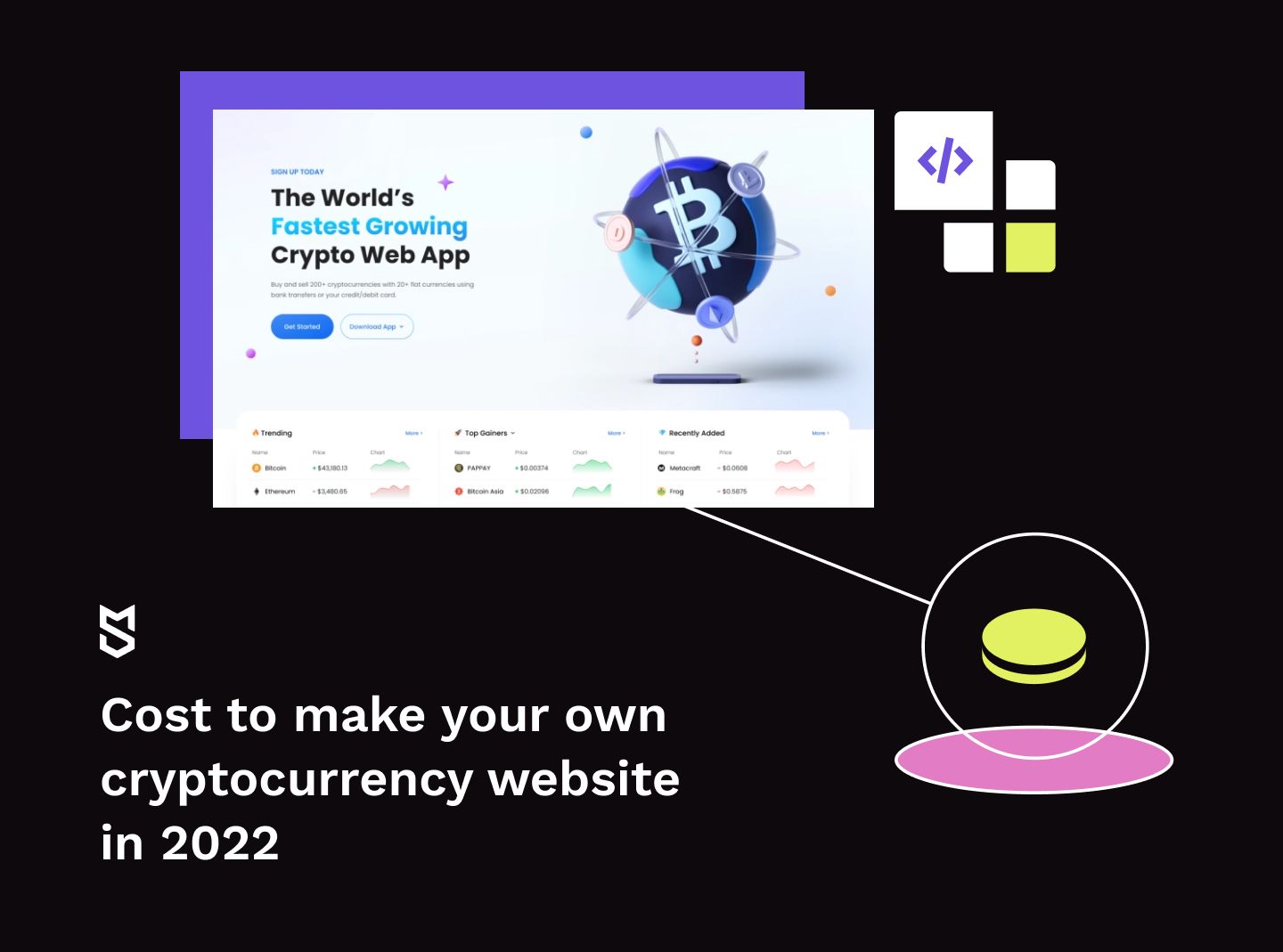
So we’ve approached the cost to make your own cryptocurrency exchange website. Let’s investigate the stages of development and estimate the time and costs needed to make a CEX platform from scratch:
| Stage | Time, h | Cost, USD |
|---|---|---|
| Business analysis and market research | 60+ | 2,700 |
| Prototyping and UI/UX design | 160 | 7,200 |
| Front-end development | 480+ | 21,600 |
| Backend development | 390+ | 17,550 |
| Project management | 180 | 8,100 |
| Testing | 240 | 10,800 |
| Total | 1,510 + | 67,950 + |
You should have in the neighborhood of 3,5 months and $68,000 to develop an MVP for a centralized crypto exchange platform. Remember that the cost can vary depending on the scale of the project, the technologies used, and the hourly rate of your development team.
If you want to know the cost to develop a DEX/HEX website or an iOS/Android crypto exchange mobile app, drop us a line, and our experts will provide you with an approximate estimate.
How to find a crypto-based product development team?
Here’s the development team you should hire for building a cryptocurrency exchange website:
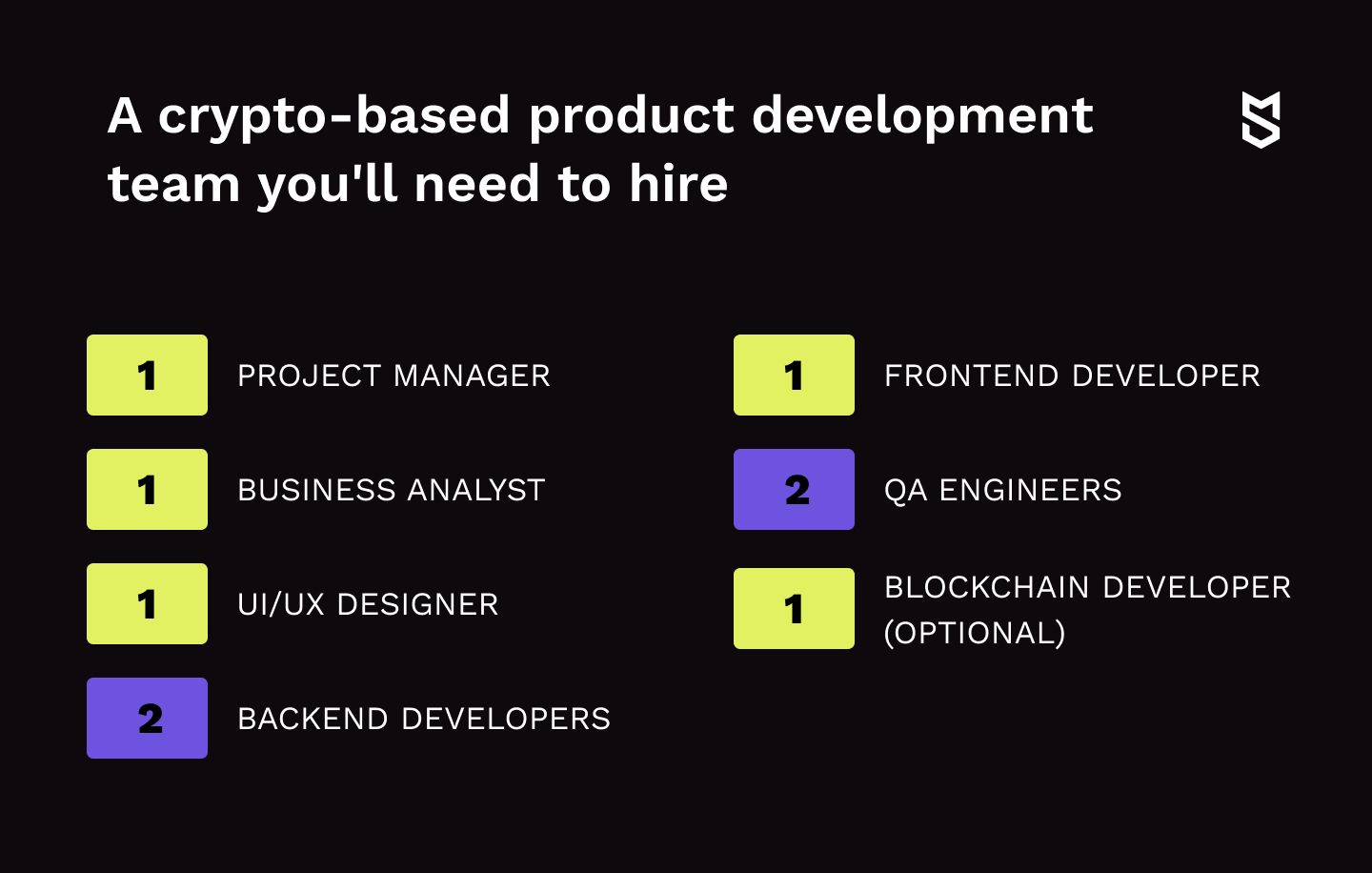
When it comes to finding a trustworthy crypto exchange development team, you can follow six proven rules:
- Define your acceptance criteria and look for companies that perfectly match them using platforms like Clutch or Good Firms.
- Personally contact companies’ previous customers and based on their feedback, prioritize companies with a well-organized development process.
- Get in touch with three to five candidates and while negotiating, find out which company’s DNA most resonates to you.
- From the remaining ones, prioritize teams with an aptitude for overcoming challenges and learning new things rather than a particular technology set.
- Instead of picking the cheapest hourly rate, choose those companies which provide you with a reasonable estimate and billing clarity.
- Check whether you choose the right development partner by entrusting them with a small initial task.
As for Mind Studios, we have a couple of projects related to crypto, NFT, and blockchain in our portfolio:
- In 2018, we successfully built an app for gamers to help them stay active and keep in shape. The project involved FitBit third-party APIs integration, custom Minecraft plugin development, and Ethereum blockchain-based product architecture with the capability of converting its native MCF tokens into Ethers.
- From the beginning of 2022, we have been involved in developing a blockchain-based gaming ecosystem Xmanna. We’re working on creating the MannaVerse where various sports teams can provide a completely different type of engagement for their fans. This project encompasses a couple of games we’ll be co-creators of, including card games and live 3rd-person multiplayer and 1st-person shooters.
- In April 2022, we’ve created a 2D arcade game Flappy Whales that allowed its players to use NFT sea creatures that were sold on the OpenSea marketplace, and we did it within one month.
We love to take on projects that enable us to expand our horizons, learn something new, and foster our tech-savvy skills. So we’d be miles appreciative of having your crypto exchange website as our first hallmark development project in this category.
Cryptocurrency exchange platform development: Final thoughts
According to CointMarketCap, as of August 2022, there are 291 cryptocurrency spot exchanges in the market that generate a total daily volume of over $226 billion. A year ago, however, there were a bit more exchanges — 309, but with a total daily trading volume of $193 billion — a bit less.
This means the competition on the market is high, let alone the huge impact of pandemia, the Russian-Ukrainian war, and other political and economical collapses, so some crypto startups don't survive. But the industry itself is evolved and flooded with more and more funds.
Writing an article on how to make a bitcoin exchange website and trying to make the process look all sunshine and rainbows would be dishonest, and that's something we won't ever do.
The crypto industry is harsh and full of hidden pitfalls. Even if you enlist help from a trustworthy web development company, it will still be a lot of work. But in the end, your efforts will all pay off in the way of profits. And one day, you might find yourself an owner of a business that doubles its annual revenue!
When Elon Musk left Stanford in the late 1990s to start an internet company, he said: “I could either watch it happen or be a part of it”.
So what’s your decision on crypto website development? If you’re ready to start, contact us.


